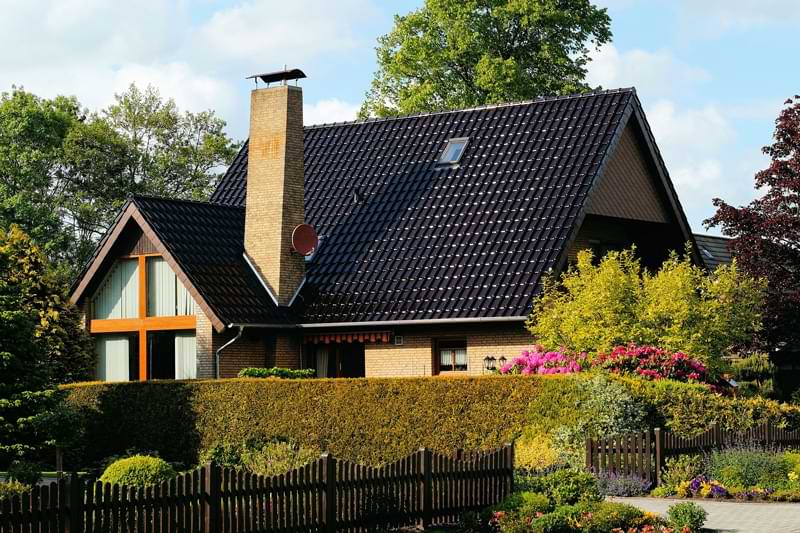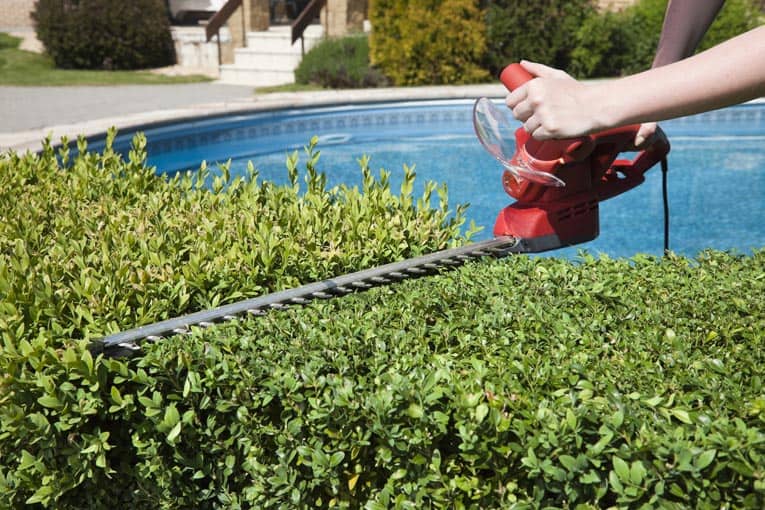How To Get Hedge Diy
Hedges are living walls. Formed by shrubs or pocket-sized trees, they can be used to cake views, delineate boundaries, create garden rooms, or serve as a backdrop for other plantings. Depending on the plants you choose, hedges can be formal with a mass of green leafage or wildly exuberant and covered with blooms.
Leafage, whether accompanied by flowers or not, defines hedges. Plants that make practiced hedges take close-set branches with lots of leaves that start at ground level and continue to the top of the plant.

Virtually hedges are evergreen. If you don't mind or really want bare branches or complete dieback in the winter, though, you can find expert hedge plants that are deciduous.
Hedges autumn into three categories: formal, semiformal, and breezy. Each has its own place in garden design, and each has its own requirements for pruning and training.
Formal Hedges
Formal hedges are the neatly trimmed, symmetrically shaped perimeters that well-nigh people kickoff call back of when they hear the word "hedge." These hedges are created from a single species or diversity with a dense growth habit of small leaves. They can range from only a human foot high to well over half dozen feet tall. The overall impression is of a solid cake of greenery rather than a single establish.
Boxwood (Buxus) is the classic plant for a formal hedge, but other choices include barberry (Berberis), hemlock (Tsuga), holly (Ilex), and yew (Taxus). Bamboo can also be a formal hedge choice, but you lot will need to buy a clumping multifariousness and keep it well in check.
Semiformal Hedges
Semiformal hedges are also usually composed of a single species or variety of found. The difference is that the leaves are generally larger and stand out equally individuals rather than a mass, and the overall found form is somewhat less rigid. English language laurel (Prunus laurocerasus), firethorn (Pyracantha), and photinia are all good choices.
Informal Hedges
Rather than having a rigid, geometric shape, informal hedges are casual, creating a barrier that may change from tall to curt and from broad to narrow. This style works well in natural and cottage gardens, with their emphasis on loose course and a mix of plants. In fact, mixing a number of different hedge plants is a good way to create an informal hedge—a adept pick for flowering plants, as they tin can be pruned and shaped then bloom production isn't inhibited.
Minor, informal hedges can be created from lavender (Lavendula) or santolina; medium informal hedges may consist of junipers or weigela; taller hedges might be comprised of oleander (Nerium oleander), osmanthus, or photinia.
Hedge Buying Considerations
Considering hedges are grown from shrubs or copse, y'all'll observe them sold as bare-root plants, as balled-and-burplapped (or b-and-b) plants, with their roots surrounded by soil and wrapped in burlap or mesh, or in containers. The first two are normally sold in late fall and early on spring; constitute these as shortly every bit y'all buy them.

Go along in mind that while the combination of roots and soil that form the balls of b-and-b plants can be heavy, the roots themselves are frail. Handle these plants with care when moving them. Container plants tin be put out at whatever time the ground tin be worked, but try to avoid planting during the heat of the solar day or during a hot spell to avoid stressing the plant.
Choose plants with stiff stems and good root systems. For b-and-b plants, whose roots are not visible, exist certain the roots are not exposed and the root ball is business firm and moist. Container plants should non be root-leap nor too leggy.
Hedge Planting Basics
When you're planting a hedge, y'all're planting multiple plants. One of the virtually of import considerations is how far autonomously to space them. Too close and the mature plants will be entangled and won't grow well. Also far apart and you'll take gaps. The rule of thumb is to plant slightly closer together than you commonly would. For instance, if you normally establish 3 anxiety autonomously, plant ane to ii feet apart instead. If spacing would normally exist half-dozen feet, go for 4 feet.
Start with a hole that is twice the width of the roots of the found and slightly shallower than the root system. Taper the sides of the hole outward slightly at the bottom, then dig deeper effectually the edges at the bottom of the pigsty to permit room for the roots to grow down and to prevent the soil from settling. Shape the soil in the center of the hole into a rounded cone, which will serve as a base for the establish.
Soak a bare-root plant in h2o for four hours earlier planting. Situate the institute so the top of the rootball is slightly above the surrounding soil. Spread the roots over the cone and downward. Hold the constitute in place and so begin filling in the hole with the soil you removed. Brand certain the soil is firmly in place as you fill in the space.
When the soil is about four inches from the pinnacle, add water to settle the soil in place. If the found starts to settle, add more soil under information technology until information technology is again at the proper height above the soil. Cease filling in with soil, and and so h2o again. Don't overwater; the soil should be moist only not soggy.
Pruning & Trimming Hedges
All hedges volition require some pruning to remove dead and diseased woods and wayward branches. Other than that, the style of hedge and the plants themselves decide how you lot prune to shape the hedge.
For a formal hedge, prune deciduous plants back to about half their size in autumn, to encourage growth in the lower part of the plant. Fast-growing evergreens with broad leaves tin can as well be pruned back at this time, though non every bit severely. Small-leafed evergreens don't demand to be cutting just tin can exist shaped by pinching or removing branches that are growing out of bounds.
In one case established, formal hedges should be pruned while growing in bound. The plants don't need to be individually cut. Instead, shear the sides and tiptop with hedge clippers or a hedge trimmer to create your last desired shape.
Mutual shapes include rectangular, cone-shaped, or rounded. In whatever case, taper the sides so they are wider at the lesser than at the acme. This will allow sunshine to reach the lower branches and forbid them from thinning out. Fast-growing plants may need to be pruned again before midsummer, and y'all'll e'er want to remove any wayward branches.
Semiformal hedges are pruned at the same time as formal hedges. Shearing isn't skilful for these plants as it will go out bare spots and exposed cuts. Instead, use pruning shears to cut individual branches.
Informal hedges don't demand to be pruned later on planting; instead, periodically pinch-back the tips to keep the plants bushy. Y'all may need to continue pinching the second year as well. Beyond that, prune as needed, following the regular recommendations for the individual plants.
How To Get Hedge Diy,
Source: https://www.hometips.com/diy-how-to/hedges-planting.html
Posted by: poarchcouspit.blogspot.com


0 Response to "How To Get Hedge Diy"
Post a Comment